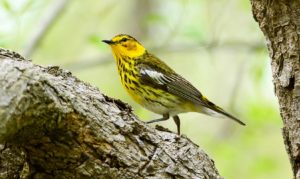It is hard to go outside these days without feeling like there aren’t as many birds around as there used to be. Well, finally there is a detailed study to document that decline. According to an analysis by an international team from seven institutions, the North American bird population has declined by nearly 30% over the last 50 years. This research, which was published in the journal Science this past week, shows massive losses among U.S. bird populations—with steep declines in every habitat. For example, grassland bird populations have decreased by 53%, shorebirds have declined by 37%, and boreal forest birds have declined by 39%. The report is sobering, revealing a classic canary-in-a-coal-mine scenario, and should be read and understood by everybody, not just by birders. Click here to view a summary of the report.
More than 90% of the total loss of birdlife in the U.S. and Canada comes from just 12 avian families, including familiar families such as sparrows, warblers, blackbirds, and finches, and they are all decreasing. Multiple common or familiar species have declined more than 40% within that interval, including Ruddy Turnstone (down 80%), Northern Bobwhite (down 78%), Eastern Meadowlark (down 80%), and Baltimore Oriole (down 44%). Diverse species such as Bobolink, Chimney Swift, Black-billed Cuckoo, Cape May Warbler, Long-eared Owl, Eastern Whip-poor-will, and Olive-sided Flycatcher have all suffered strong declines. Click here to view the report on the state of the birds in 2019.
What has caused the decline? Ultimately, the problem boils down to having too many people on this planet. In 1900 there were 1.6 billion people on earth; by the year 2000 there were 6 billion, and by 2050 world population is expected to reach 9.6 billion people. This growth is not sustainable, since the earth has limited resources. We (not sharks) are the top predator, and our consumer society means just that…we consume and consume and consume, and the planet and nearly everything else that lives on it suffers. The result is extensive habitat loss to provide homes and food and supplies for the ever-growing population, resulting in loss of plants and animals that are lower on the food chain. As our plants, insects, and other animals continue to dwindle it ultimately will come back and hurt humans as well. I highly recommend watching a video presentation by Sir David Attenborough that puts population growth in perspective. Human-caused habitat loss is the main cause of bird deaths, followed by domestic and feral cats, window and building strikes, cars, collisions with power lines, wind turbines, and continued hunting/harvesting.
To reverse this process, steps have to be taken at governmental levels, such as protecting endangered species and passing legislation and funding efforts to protect wetlands and grasslands. But what can we do as individuals to help the recovery? Seven simple steps are suggested on the Cornell web site, including keeping cats indoors, switching to drinking shade-grown coffee, reducing plastic consumption, not using pesticides on our lawns, and promoting native plants. A more detailed description of those seven steps can be found by clicking here. It would help if we all do our part to keep birds and other wildlife from declining further.
